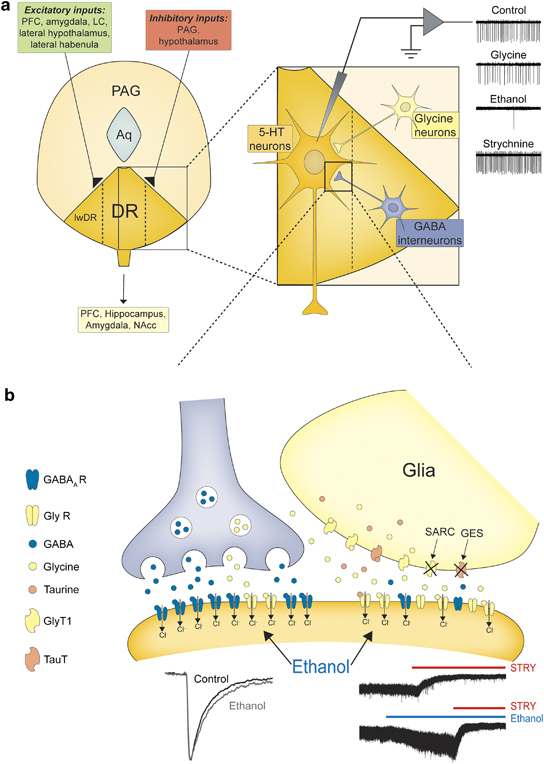Figure 7.

A model for the role of inhibitory transmission in the mouse dorsal raphe nuclei and the relevance of modulation of the glycinergic conductance to the DR neuronal output. (a) A simplified schematic representation of the topographical organization of dorsal raphe nuclei illustrating its principal neuronal inputs and outputs. Inhibitory inputs to 5-HT neurons (ochre) are mediated by both GABAA receptors (GABAARs) and strychnine-sensitive glycine receptors (GlyRs). GABAergic inputs (grey) are mainly, but not exclusively, of local origin, whereas the glycinergic neuronal inputs (yellow) originate out with the dorsal raphe (eg, PAG and the reticular system). In addition, glial-derived taurine/β-alanine (salmon pink) and glycine can activate the inhibitory tonic conductance (see below). The glycinergic conductance exerts a powerful control over DR neuronal excitability (see traces right). Enhancement of the conductance by glycine or by ethanol and suppression by strychnine significantly reduces and increases, respectively, the action potential discharge of DR 5-HT neurons. (b) Our findings indicate that DR 5-HT neurons utilize a unique synergistic organization for inhibition whereby GABAARs (blue) primarily mediate synaptic or ‘phasic' inhibition, whereas extra-synaptic GlyRs (yellow) provide a large ‘tonic' conductance that profoundly decreases neuronal excitability (top trace right). A behaviorally relevant concentration (30 mM) of ethanol selectively enhances the extrasynaptic (bottom trace right) and synaptic (left trace) glycinergic conductance to consequently suppress DR neuronal firing (see traces in panel (a)) but has little effect upon GABAAR-mediated synaptic inhibition. The large GlyR-mediated conductance is additionally greatly increased by clomethiazole, which is used clinically to treat alcohol withdrawal (Williams and McBride, 1998), and by sarcosine, which inhibits the GlyT1 transporter, an action recently reported to decrease ethanol intake and preference in rats (Molander et al, 2007). Moreover, taurine, an ingredient of certain energy drinks, often taken together with ethanol, enhances the effect of ethanol upon the tonic glycinergic conductance (see Discussion for additional details). PFC, prefrontal cortex; LC, locus coreleus; Aq, aqueduct; PAG, peri-aqueductal grey; DR, dorsal raphe; lwDR, DR lateral wing; NAcc, nucleus accumbens; GlyT1, glycine transporter 1; TauT, taurine transporter.
